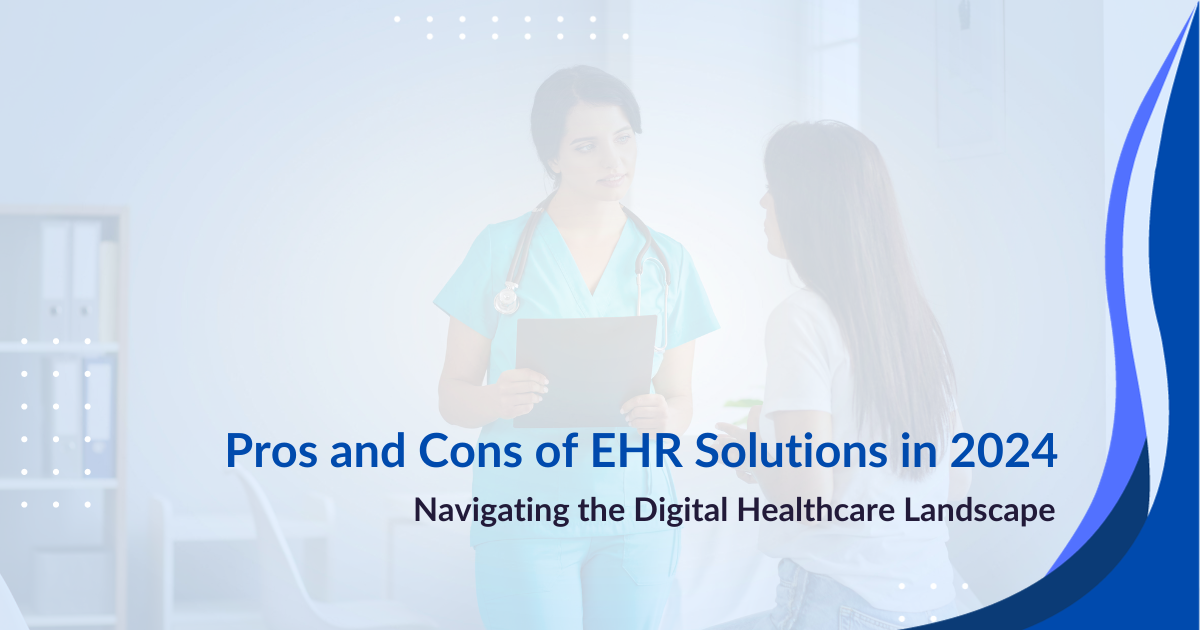Introduction
In the ever-evolving landscape of healthcare, Electronic Health Records (EHR) have become an integral part of medical practice, promising improved patient care, enhanced efficiency, and better data management. As we step into 2024, it’s essential to examine the pros and cons of EHR solutions, focusing on their impact and evolution. In this blog, we will delve into the benefits and drawbacks of EHR software, with a particular emphasis on integrated EHR software
Pros of Electronic Health Record Software
- Enhanced Data Accessibility and Sharing
One of the primary advantages of EHR solutions in 2024 is the ease of access to patient data. Integrated EHR solutions allow healthcare providers to access a patient’s complete medical history, including diagnoses, treatments, medications, and test results, at the touch of a button. This improved data accessibility facilitates quicker and more accurate decision-making, leading to better patient care and safety.
- Improved Efficiency
Electronic Health Records Software streamlines administrative tasks, reducing paperwork and manual data entry. This enhanced efficiency leads to time and cost savings for healthcare facilities. It also enables healthcare professionals to focus on patient care rather than cumbersome administrative duties.
- Better Patient Engagement
EHR solutions often come with patient portals that allow individuals to access their medical records, communicate with healthcare providers, schedule appointments, and request prescription refills. This improved patient engagement fosters a sense of empowerment and encourages proactive healthcare management.
- Integration with Other Healthcare Systems
In 2024, EHR system are expected to be more seamlessly integrated with other healthcare systems, such as pharmacy management, radiology, and laboratory systems. This integration results in a comprehensive healthcare ecosystem where data flows seamlessly between different providers and systems, promoting better coordination of care.
- Data Analytics and Insights
The wealth of data stored in EHR systems can be harnessed for research and analysis. EHR software provides the ability to generate reports and gain insights into patient demographics, treatment outcomes, and disease trends. This data-driven approach can help healthcare organizations make informed decisions and improve patient outcomes.
- Cost Reduction
While the initial implementation of EHR/EMR solutions can be costly, in the long run, they can lead to significant cost savings. Reduced paperwork, streamlined processes, and better inventory management can result in a more cost-effective healthcare system. Moreover, integrated EHR solutions can help prevent duplicate tests and procedures, reducing healthcare expenditures.
- Enhanced Decision Support
EHR software often includes decision support tools that provide healthcare professionals with alerts and reminders about important aspects of patient care. This can include drug interaction warnings, vaccination schedules, and recommended treatments, ensuring that providers follow evidence-based guidelines.
- Accessibility and Telehealth
With the growing popularity of telehealth, EHR Platform enable healthcare providers to access patient data remotely, making telemedicine more efficient and patient-centered. Patients can also connect with their healthcare providers online, enhancing access to care, especially in remote or underserved areas.
Cons of Electronic Health Record Software
- Implementation Challenges
The transition to EHR software can be challenging and time-consuming. Healthcare providers need to adapt to new workflows, and data migration from paper-based records to digital formats can be complex. The implementation process can lead to temporary disruptions in patient care.
- Privacy and Security Concerns
With the digitization of medical records, data security and patient privacy are paramount concerns. EHR systems are attractive targets for cyberattacks, and breaches can lead to sensitive patient information being compromised. As the technology evolves, so do the tactics of cybercriminals, necessitating continuous updates and security measures.
- Interoperability Issues
While integrated EHR solutions are designed to improve data sharing, interoperability remains a significant challenge. Different healthcare systems may use different EHR software, leading to data silos that hinder seamless information exchange. Interoperability issues can compromise the continuity of care.
- Learning Curve
Adopting EHR software often requires healthcare providers and staff to undergo training to use the system effectively. The learning curve can vary, and some professionals may find it challenging to adapt to the new technology, which may temporarily impact productivity.
- Data Entry Burden
Although EHR software is designed to streamline administrative tasks, healthcare providers can still find data entry to be burdensome. Inputting patient information and updating records can be time-consuming, taking away from valuable time spent with patients.
- Risk of Information Overload
The wealth of data generated by EMR solutions can lead to information overload. Healthcare professionals may struggle to sift through extensive patient records to find the most relevant information, potentially impacting decision-making and patient care.
- Financial Costs
While EHR software can lead to long-term cost savings, the initial implementation and ongoing maintenance costs can be significant. Smaller healthcare facilities, in particular, may find it challenging to invest in EHR solutions, even if they are more affordable than in the past.
- Compliance Requirements
Healthcare providers must comply with various regulations and standards, such as HIPAA (Health Insurance Portability and Accountability Act) in the United States. Meeting these compliance requirements can be demanding, with penalties for non-compliance.
Future Trends and Evolutions of EHR/EMR Software
As we move further into 2024, it’s important to consider emerging trends and future evolutions of EHR solutions. Some key developments to watch for include:
- Artificial Intelligence (AI) and Machine Learning Integration: EHR/EMR solutions are expected to increasingly incorporate AI and machine learning algorithms for data analysis, predictive analytics, and early disease detection.
- Blockchain for Data Security: The use of blockchain technology may become more prevalent in securing patient data and improving data sharing across different healthcare entities.
- Improved Interoperability: Efforts to enhance interoperability between different EHR systems and healthcare providers will continue, promoting seamless data exchange.
- Mobile Health (mHealth) Integration: EHR solutions are likely to integrate more fully with mobile health applications, enabling patients to monitor their health and provide real-time data to their healthcare providers.
- Enhanced Telehealth Features: The integration of EHR/EMR software with telehealth platforms is expected to improve, offering more robust features for remote patient care.
- Personalized Medicine: Electronic Health Record software will play a vital role in the development of personalized medicine, tailoring treatments to individual patient profiles.
- Patient Ownership of Data: As data privacy concerns continue to grow, patients may have more control and ownership of their health data, with the ability to share it securely with healthcare providers when needed.
Conclusion
EHR solutions have come a long way in transforming the healthcare industry, offering numerous benefits such as enhanced data accessibility, improved efficiency, and better patient engagement. However, they also present challenges, including implementation issues, privacy concerns, and interoperability issues.
As we progress into 2024, it’s crucial for healthcare organizations to carefully evaluate the pros and cons of EHR solutions, taking into account their specific needs and circumstances. While the adoption of EHR/EMR software can be complex, the potential for improved patient care, data-driven decision-making, and cost savings makes it a vital component of modern healthcare. Staying abreast of evolving trends and technologies will be essential for healthcare providers and organizations looking to make the most of Electronic Health Record solutions in the years to come.











